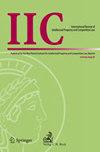Framing Texts and Images: Critical and Posthumous Editions in the Digital Single Market
IF 1.4
Q1 LAW
IIC-INTERNATIONAL REVIEW OF INTELLECTUAL PROPERTY AND COMPETITION LAW
Pub Date : 2023-10-18
DOI:10.1007/s40319-023-01394-9
引用次数: 0
Abstract
Abstract Although Art. 14 of the Directive on Copyright in the Digital Single Market (CDSM Directive) was introduced mostly to deal with issues connected with non-original photographs of public domain works, it also impacts the protection of posthumous and critical editions. Whenever a work of visual art that belongs in the public domain becomes the object of an edition, Art. 14 CDSM Directive excludes its protection under neighbouring rights. In the case of complex works, embedding original contributions belonging to different genres, Art. 14 CDSM Directive applies only if visual elements are predominant in the given work and as long as it is not possible to exploit the work of visual art without using other contributions embedded in the complex work. At the same time, Art. 14 CDSM Directive indirectly confirms that an edition may be protected by copyright if it is original. The particularly low threshold of originality required makes the presence of copyright quite common in three-dimensional and two-dimensional reproductions of works in the public domain that can qualify as editions. Then, with reference to textual works, the limits of originality are challenged: although there is little doubt that the person preparing a critical edition faces choices, they may not necessarily be free and creative. Editorial interference with the text can be compared to findings made by historians during their research and, as such, remain unprotected by copyright. Such an edition may still be protected within the regime of the neighbouring right in those few member states that decided to implement it. Eventually, as is the case nowadays with many aspects of human activity, the future of IP protection of various editions will become murkier due to the advent of new artificial intelligence technologies. For example, models are already being developed to automate the arduous and difficult process of transcription of manuscripts, as well as to ensure appropriate restoration of works of visual art. In particular, the further rapid development of artificial intelligence may cause the neighbouring rights in editions to become at least partially obsolete if the process of preparation of editions becomes devoid of human input. And this would have an impact on the copyright presence as well.框架文本和图像:数字单一市场中的批判和死后版本
尽管《数字单一市场版权指令》(CDSM指令)第14条的引入主要是为了处理与公共领域作品的非原创照片有关的问题,但它也影响了对死后版本和批评版本的保护。当属于公共领域的视觉艺术作品成为版本的对象时,CDSM指令第14条将其排除在邻接权的保护之外。对于复杂作品,嵌入属于不同类型的原创作品,CDSM指令第14条仅适用于视觉元素在给定作品中占主导地位,并且只要不使用嵌入在复杂作品中的其他贡献就不可能利用视觉艺术作品。同时,CDSM指令第14条间接确认,如果一个版本是原创的,则该版本可能受到版权保护。独创性要求的门槛特别低,这使得在公共领域对作品进行三维和二维复制时,版权的存在相当普遍,这些作品可以被视为版本。然后,参考文本作品,独创性的限制受到挑战:尽管毫无疑问,准备批评版本的人面临选择,但他们可能不一定是自由和创造性的。编辑对文本的干扰可以与历史学家在研究过程中的发现相比较,因此不受版权保护。在少数决定实施这种版本的成员国中,这种版本可能仍然受到邻接权制度的保护。最终,就像现在人类活动的许多方面一样,由于新的人工智能技术的出现,各种版本的知识产权保护的未来将变得更加模糊。例如,已经在开发模型,使抄写手稿这一艰巨而困难的过程自动化,并确保适当地修复视觉艺术作品。特别是,人工智能的进一步快速发展,如果版本的准备过程变得缺乏人力投入,可能会导致版本的邻接权至少部分过时。这也会对版权的存在产生影响。
本文章由计算机程序翻译,如有差异,请以英文原文为准。
求助全文
约1分钟内获得全文
求助全文
来源期刊
CiteScore
1.90
自引率
30.00%
发文量
127
期刊介绍:
The International Review of Intellectual Property and Competition Law (IIC) is a peer-reviewed academic journal published by the Max Planck Institute for Innovation and Competition. Founded in 1970, IIC is one of the most respected journals in the fields of intellectual property and competition law, presenting contributions with the highest standards of academic research.
IIC publishes research on the most significant developments in IP and competition law from around the world. Our aim is to provide a European perspective on these important topics to an international audience.
The journal adopts a multidisciplinary approach and offers a platform for opposing ideas, providing for rich debate on a host of current IP and competition law issues.
The journal’s central feature is high-quality authored materials including articles, editorials, opinions, reports, case notes and book reviews. We also translate and publish the leading decisions from jurisdictions worldwide, including many non-mainstream jurisdictions.
The quality of IIC is grounded on a more than 50-year history of publication. Each volume builds on this tradition of academic excellence. Our established foundation provides a unique platform upon which our readers are able to research and explore emerging developments in IP and competition law in the decades to come.

 求助内容:
求助内容: 应助结果提醒方式:
应助结果提醒方式:


